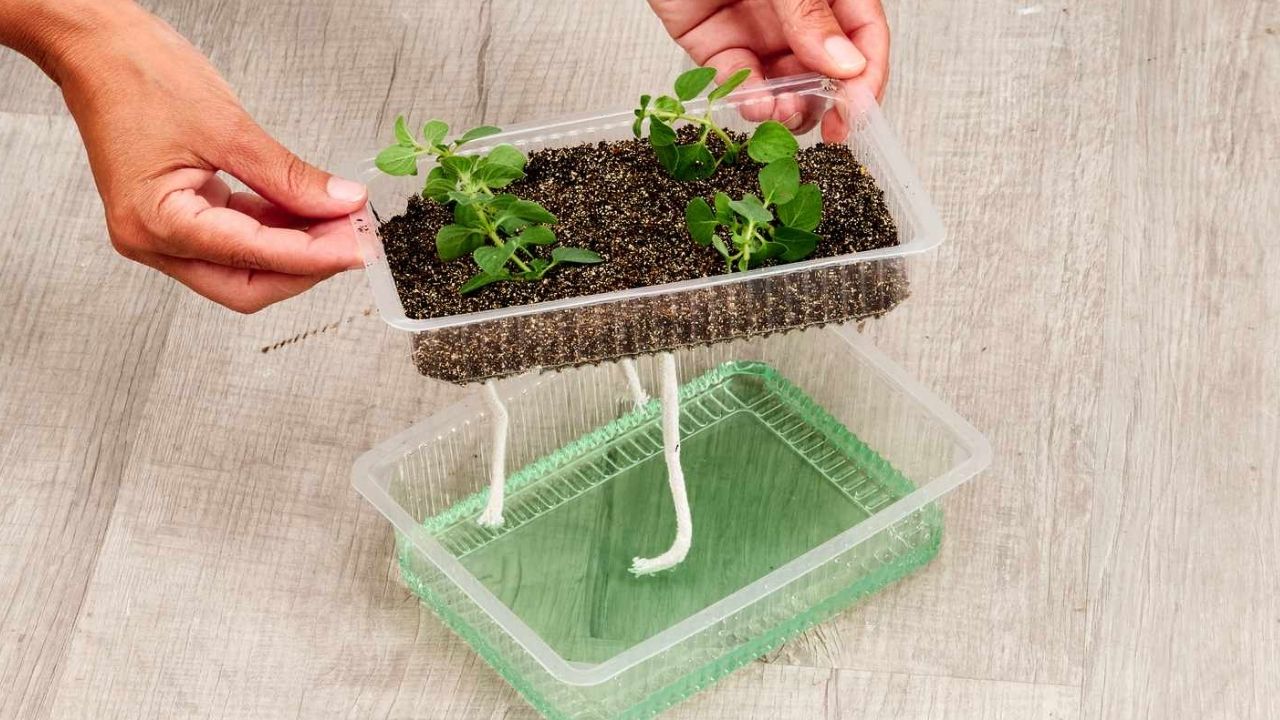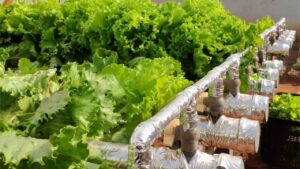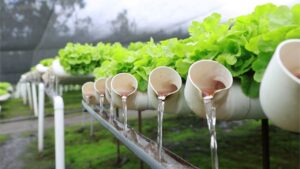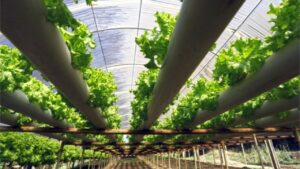As cities grow and the demand for sustainable solutions increases, urban gardens have become a popular way to produce fresh and healthy food. In this context, hydroponics emerges as an innovative and practical technique that allows plants to grow without soil, using a nutrient-rich solution to feed their roots directly.
Hydroponics is not just a modern trend but a solution to the space and resource limitations typical of urban environments. Some of its main benefits include:
- Water efficiency: the system uses up to 90% less water compared to traditional farming.
- Efficient use of space: vertical structures allow cultivation even in small areas.
- Sustainable production: controlled cultivation reduces pesticide use and environmental impact.
In this article, we’ll guide you step by step on how to set up your own hydroponic garden at home, helping you produce fresh food in a practical and sustainable way. Get ready to transform small spaces into big opportunities for growth!
What is Hydroponics and How Does it Work?
Hydroponics is a cultivation technique that eliminates the use of soil, replacing it with a nutrient-rich solution that provides plants with everything they need to grow. The term “hydroponics” comes from Greek and means “working with water,” highlighting the crucial role water plays in the system.
How does hydroponics work?In hydroponic farming, plants grow with their roots suspended in a nutrient solution or inert substrates such as expanded clay, rock wool, or coconut fiber. This solution contains a balanced mix of essential nutrients like nitrogen, phosphorus, and potassium, which are absorbed directly by the plants. By removing the need for soil, cultivation takes place in a controlled environment where factors like light, temperature, and pH can be optimized.
Types of hydroponic systemsThere are various hydroponic systems, each with specific characteristics to suit different types of cultivation:
- NFT (Nutrient Film Technique): A continuous flow of nutrient solution circulates around the plant roots in sloped channels, ensuring efficient absorption.
- DWC (Deep Water Culture): The roots are submerged directly in the nutrient solution, while oxygen is supplied through an aeration system.
- Aeroponics: Plants are suspended, and the nutrient solution is sprayed directly onto their roots, providing excellent oxygenation.
- Drip systems: The nutrient solution is slowly delivered to the roots or substrates, making it ideal for larger-scale cultivation.
- Ebb and Flow (or Flood and Drain System): Plants are periodically flooded with the nutrient solution, which is then drained to ensure root aeration.
Each system has its advantages and specific applications, but they all share the core principle of hydroponics: maximizing plant growth through precise control of nutrients and the cultivation environment. The best system for you will depend on your available space, resources, and the type of plants you want to grow.
Materials Needed to Start Your Hydroponic Garden
Starting a hydroponic garden at home requires a few basic materials, which can be easily purchased or creatively improvised. Here’s an essential list to get you started:
Essential Materials
- Water reservoirs
- Reservoirs are used to store the nutrient solution that feeds the plants. You can use plastic containers, large buckets, or tanks, depending on the system’s size.
- Air and water pumps
- An air pump is essential for keeping the nutrient solution oxygenated, while a water pump ensures circulation in systems like NFT and DWC.
- Tubes and fittings
- These transport the nutrient solution to the plants. PVC pipes, flexible hoses, and plastic fittings are common options.
- Substrates
- Substrates like expanded clay, rock wool, coconut fiber, or perlite provide root support, replacing soil. Choose one that suits your plants and hydroponic system.
- Nutrient solutions and meters
- The nutrient solution consists of water and essential nutrients for plant growth. Additionally, a pH meter and an EC (electrical conductivity) meter are crucial to maintaining the solution’s balance and optimizing plant performance.
Budget-Friendly Options and Reuse Tips
- Improvised reservoirs: Cleaned paint buckets, storage bins, and large bottles can be repurposed as reservoirs.
- Recycled pipes: Used PVC pipes can be adapted to create channels for nutrient solution circulation.
- Homemade solutions: Some people start with basic homemade nutrient solutions, though specialized products are ideal for better balance.
- Alternative substrates: Washed sand and fine gravel are budget-friendly options that can work as substrates in simpler systems.
With these materials and a touch of creativity, you can build an efficient and sustainable hydroponic system at home, cutting costs and reusing materials whenever possible. Remember: simplicity is the first step toward growing practically and ecologically!
Choosing the Ideal Location for Your Hydroponic Garden
The success of a hydroponic garden depends not only on materials and nutrients but also on where it is installed. Selecting the right space ensures that your plants receive the optimal conditions for healthy and productive growth.
Light: The Key Growth Factor
Light is essential for photosynthesis, and hydroponic plants need adequate exposure to thrive.
- Natural light: Choose a location that gets at least 6 hours of direct sunlight per day. Balconies, terraces, and windows facing north (in the Southern Hemisphere) or south (in the Northern Hemisphere) are excellent options.
- Artificial lights: If sunlight is limited, invest in grow lights, such as full-spectrum LEDs, which mimic natural light and promote efficient plant growth.
Ventilation and Temperature
A well-ventilated environment is crucial to avoid excessive humidity, which can lead to issues like mold and fungi. Ensure the chosen location has natural airflow or use small fans to maintain air circulation.
- Temperature: Most plants grow best in temperatures between 18°C and 26°C (64°F and 79°F). Avoid areas with extreme heat or cold, such as near overly exposed windows or in stuffy, closed spaces.
Adapting to Small Spaces
Hydroponics is an incredibly versatile technique, perfect for places with limited space. Here are some ideas to make the most of small areas:
- Balconies and terraces: Use vertical or shelf systems to maximize available space.
- Sunny windows: Set up smaller systems, like DWC or drip systems, near well-lit windows.
- Indoor setups: Adapt compact systems with grow lights to create a mini garden in any room of the house.
Regardless of the space available, the key is to ensure your plants have access to light, proper ventilation, and a stable environment. With planning and creativity, you can set up a productive hydroponic garden anywhere!
- See Also: Transforme Seu Quintal ou Sacada em uma Horta Funcional e Sustentável
- Follow – Us: https://www.facebook.com/profile.php?id=61565415975218
Step-by-Step Guide to Setting Up Your Hydroponic Garden
Setting up a hydroponic garden at home may seem challenging, but with proper planning and the right materials, you’ll be growing your own plants in no time. Follow this practical guide to create your system efficiently.
1. Preparing the space
- Choose a location with good sunlight exposure or prepare to install grow lights.
- Ensure the area is flat and protected from strong winds or extreme temperatures.
- Organize the space so that the hydroponic system has easy access to electricity (for pumps) and is easy to maintain.
2. Assembling the system
Connecting pipes and reservoirs
- Set up PVC pipes or growing channels, ensuring a slight incline to allow the nutrient solution to flow (in systems like NFT).
- Connect the pipes to the main reservoir, which will store the nutrient solution.
Installing pumps and meters
- Place the water pump inside the reservoir and connect it to the pipe system to circulate the solution.
- Install an air pump if needed to maintain oxygen levels in the water.
- Position pH and EC meters to monitor the solution’s levels consistently.
3. Preparing the nutrient solution and filling the system
- Mix the nutrient solution according to the manufacturer’s instructions, ensuring the correct proportion of nutrients in the water.
- Use the pH meter to adjust the level between 5.5 and 6.5, which is ideal for most plants.
- Fill the reservoir with the solution and ensure it circulates properly through the system.
4. Planting seedlings in the substrates
- Select healthy seedlings with well-developed roots to ensure easier adaptation to the hydroponic system.
- Place the seedlings in the substrates (such as expanded clay or rock wool) and position them in the designated spots in the system.
- Ensure the roots are in direct contact with the nutrient solution or close enough to absorb the nutrients.
Now your hydroponic garden is ready! Regularly monitor the system to adjust pH and EC levels and ensure the plants receive the necessary nutrients and oxygen. With care and attention, you’ll have a constant supply of fresh, healthy food at home.
Maintenance and Care of Your Hydroponic Garden
A hydroponic garden requires consistent care to ensure that the plants are receiving the ideal nutrients and conditions for healthy growth. Below, we’ll explain the main maintenance tasks and practices you should follow to keep your hydroponic system running efficiently.
1. Daily Monitoring of pH and Nutrient Levels
- pH: The pH of the nutrient solution should be checked daily, as it directly affects the plant’s ability to absorb nutrients. The ideal pH range for most plants is between 5.5 and 6.5.
- Nutrient Levels (EC): Electrical conductivity (EC) indicates the concentration of nutrients in the solution. It’s important to regularly check if the levels are suitable for the type of plants you’re growing. EC should stay within the recommended range for each type of crop.
2. Changing and Replacing the Nutrient Solution
- The nutrient solution needs to be replaced regularly, typically every 2 to 3 weeks, to prevent the buildup of impurities and ensure the plants receive fresh nutrients.
- When changing the solution, be sure to clean the reservoir and the system pipes to avoid the growth of fungi or bacteria.
- If needed, top off the solution with the correct amount of nutrients to maintain balance and plant health.
3. Identifying Common Problems
Excessive Algae
- Algae can grow in the nutrient solution or in areas of the system exposed to too much light. To prevent algae growth, cover the reservoir with opaque materials or install a lid to block light.
- If algae are already present, thoroughly clean the system, replace the nutrient solution, and reduce exposure to direct light.
Nutrient Deficiencies
- Nitrogen Deficiency: Yellowing leaves, especially older ones, may indicate a lack of nitrogen.
- Phosphorus Deficiency: Purple leaves or slow growth may be signs of phosphorus deficiency.
- Potassium Deficiency: Leaves with burnt edges or yellowish spots may indicate a lack of potassium.
- If you notice any of these symptoms, adjust the nutrient solution accordingly and consult a nutrient guide to ensure you’re providing the correct dosages.
Maintaining your hydroponic garden requires attention and care, but with practice, you’ll gain a good understanding of how to balance nutrients, manage pH, and avoid common issues. Regular maintenance will help ensure that your plants thrive and produce great results!
Best Plants for Hydroponic Gardens
When setting up a hydroponic garden, it’s essential to choose plants that adapt well to this system, ensuring healthy growth and abundant harvests. Some plants are easier to grow hydroponically, making them ideal for beginners. Additionally, there are specific varieties that thrive in soil-free cultivation. Check out the best options for your hydroponic garden!
Best Plants for Beginners
- LettuceLettuce is one of the most popular and easiest plants to grow in hydroponic systems. It grows quickly and requires minimal care, making it an excellent choice for beginners. Common varieties of lettuce in hydroponic gardens include Romaine, Butterhead, and Leaf Lettuce.
- BasilBasil is an herb that adapts very well to hydroponic cultivation. It grows quickly and requires little maintenance, making it perfect for beginners. Additionally, basil is versatile in the kitchen, ideal for fresh seasoning.
- SpinachSpinach is another easy-to-grow plant in hydroponic systems. It prefers cooler temperatures and grows well when properly nourished, offering fresh and nutritious leaves. Spinach adapts well to systems like DWC and NFT, making it an excellent option for quick and healthy growth.
Varieties That Adapt Well to Hydroponic Cultivation
In addition to the best beginner plants, several vegetable and herb varieties thrive in hydroponic systems. These can be great options as you gain more experience with hydroponics.
- Tomatoes: While slightly more advanced, tomatoes, especially compact varieties like cherry tomatoes, can be successfully grown in hydroponic systems. They require more attention and support, but they’re an excellent choice for those with some experience in hydroponics.
- Cucumbers: Cucumbers adapt well to hydroponics, especially the vertical-growing types. They require an appropriate system like DWC or NFT to support root growth and plant development.
- Herbs like Cilantro and Mint: In addition to basil, herbs like cilantro and mint also do well in hydroponic systems. They grow well in small systems and require little maintenance, providing fresh leaves for cooking and tea.
- Kale and Arugula: Both of these leafy greens are perfect for hydroponic systems, as they grow quickly and adapt well to the setup. Kale, for example, can be grown in NFT or DWC systems with good results.
With these options, you can start your hydroponic garden simply, and as you gain confidence, experiment with other varieties. Remember, the key to success in hydroponics is choosing plants that suit your system’s needs and ensuring they receive the right nutrients!
Extra Tips to Optimize Your Production
In addition to basic care, there are several strategies and tools that can help optimize your hydroponic garden, improve system efficiency, and even create a more pleasant and functional environment. Here are some extra tips to get the most out of your hydroponic cultivation.
1. Crop Rotation to Maintain System Balance
Crop rotation is an agricultural practice that can be adapted to hydroponic cultivation to maintain system health and improve productivity. Alternate the plants grown in each cycle to ensure that the system doesn’t become imbalanced. This helps prevent the buildup of specific nutrients or depletion of certain components in the nutrient solution.Additionally, crop rotation can reduce the risk of diseases and pests, as different plants attract different types of organisms. This practice also allows you to explore a greater diversity of crops and make the most of your available space.
2. Use of Technology, Such as Automated Sensors
Technology can be a powerful ally in optimizing your hydroponic garden. Automated sensors, such as those for pH, EC (electrical conductivity), temperature, and humidity, can constantly monitor system conditions and alert you to necessary adjustments.With automated systems, you can ensure that your nutrient solution is always in the ideal conditions for plant growth, saving time and effort. Additionally, some hydroponic systems offer irrigation and lighting controls, allowing you to efficiently regulate the environment even when you’re not around.
3. How to Create an Aesthetically Pleasing Environment with Your Garden
A hydroponic garden doesn’t have to be just functional—it can also be a beautiful addition to your home or outdoor space. Here are some ideas to make your garden more visually appealing:
- Vertical Design: Use shelves, racks, or vertical systems to maximize space while giving the garden a more organized and modern look.
- Decorative Pots: Choose containers or reservoirs that complement the decor of your space. Beautiful, personalized pots can transform your garden into a focal point.
- Diverse Plants: Combine different types of plants, such as herbs, vegetables, and edible flowers, to add color and texture to your garden.
- Lighting: If your garden is indoor, invest in quality lighting that not only benefits plant growth but also creates a pleasant atmosphere.Turn your garden into a beautiful and functional space that not only provides fresh food but also becomes a part of your home’s design or outdoor garden.
With these extra tips, you can not only optimize the production of your hydroponic garden but also make it more efficient, technological, and aesthetically pleasing. Remember, the key to success lies in keeping the system balanced and taking advantage of available tools to enhance the growing experience.
Conclusion
Now that you’ve learned the key aspects of setting up and caring for a hydroponic garden, it’s time to put everything into practice! To recap the main points, we’ve covered everything from the basics of hydroponics, the materials needed, the step-by-step process to build the system, to the best plants for cultivation. We’ve also shared tips to optimize your production, such as crop rotation, the use of technology, and how to create an aesthetically pleasing environment.
Not only will you provide fresh, healthy food for your home, but you’ll also be contributing to a more sustainable lifestyle. So, why not start now? With a little patience and dedication, you’ll soon be reaping the benefits of your work!
Do you have any questions or already have experience with hydroponics? Share them in the comments! We’re here to exchange ideas, help with any questions, and celebrate each other’s successes. Let’s grow together!




